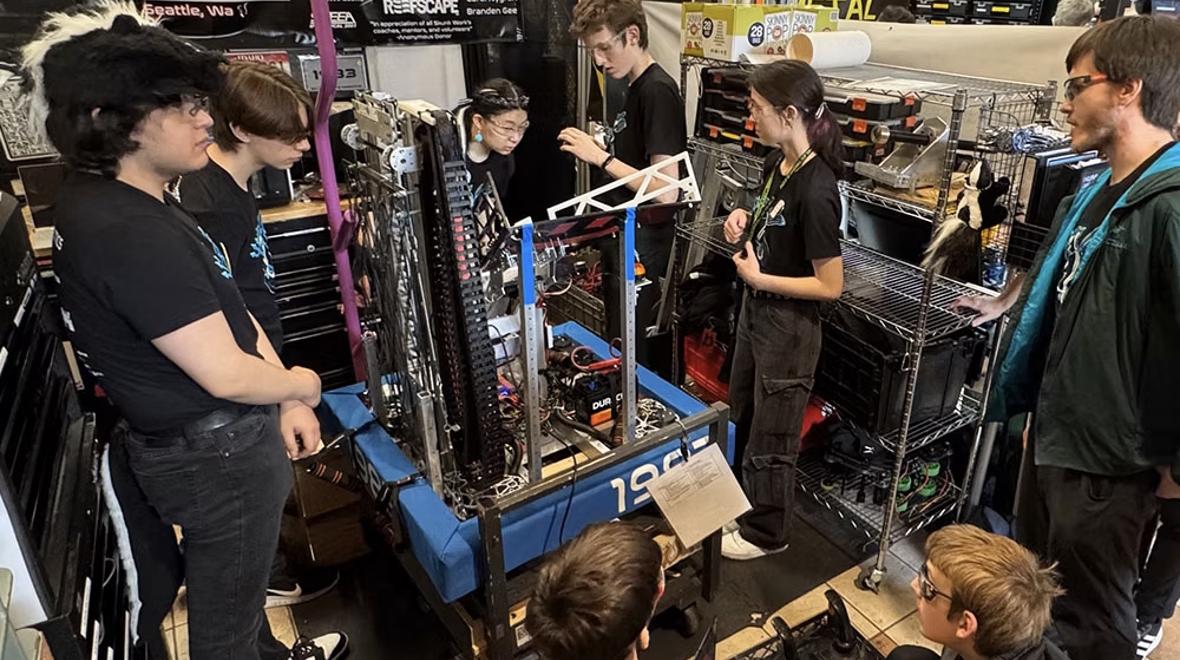
Photo:
Photo courtesy of skunkworks1983.com
From Boeing to Microsoft to Blue Origin, many leading STEM companies have called the Puget Sound area home for decades. It’s no wonder kids who have grown up here — surrounded by innovative companies that push the boundaries of technology — are often drawn to STEM-themed activities, classes and camps. And while kids’ opportunities to gain experience in these fields are seemingly endless, local robotics clubs are a popular gateway for many.
Taking the FIRST step
When West Seattle mom Erin Cranston’s son, Cameron, was about to enter high school, she wanted to help him find an activity that would keep him engaged and focused during the next four years. So she started her search where most of us do — on Google. That’s where she discovered Skunk Works Robotics, a 4H community-based robotics team, part of FIRST (For Inspiration and Recognition of Science and Technology), an international nonprofit robotics organization.
For nearly 20 years, Skunk Works Robotics teams have provided kids with the opportunity to build and program robots used in international competitions. In Cameron’s first year, the Skunk Works team and their robot, Blackbird, made it to the FIRST Championship, held in Houston each year. Although they haven’t qualified since, both Cameron and his mom see incredible value in the program.

Cranston cites the hands-on experience for kids as a noticeable benefit. “You can’t really get any better than that,” she explains. “It’s given him [Cameron] a real-world window into what people in STEM fields — like programmers or engineers — actually do.” Many of the program mentors are former Skunk Works participants or have careers in STEM fields. So when the kids encounter a problem, or need help or direction, they can turn to people who have been there. “They bring their expertise to the team,” explains Cranston.
Kids put in hour after hour building the robot over the first half of the year. As Cranston explains, “Their learning goes far beyond theory. If something doesn’t work, they work through a process to figure it out until it does. They learn to try something new or different. It’s critical thinking, problem solving and learning to work as a team every day.”
Another program benefit — being able to include robotics team experience on your résumé. For people familiar with the program, mentioning a team name is enough to open some doors. For others, program participation is a STEM elixir; more than 60 percent of program participants declare a major in engineering or computer science in college. Scholarships are another perk of many clubs.
Teams vary in size and commitment. Cranston estimates there are around 25 kids on this year’s Skunk Works team, but smaller and larger teams compete in the area as well. During the off-season, most kids spend a couple of days each week working on the robot. But that time commitment ratchets up during competition season, from January through March, to almost daily meetings.
Hands-on experience at any age
Although Cameron’s experience began during his freshman year of high school, kids as young as 4 years old can be part of FIRST Lego League. Preschoolers enrolled in the Discover program use Lego and Duplo bricks to build and create. Two additional Lego-focused programs are also available for kids in grades 2–4 (Explore) and grades 4–8 (Challenge).
FIRST Tech Challenge (FTC) is an opportunity for kids ages 12–18 to build a classroom-scale robot for competition using a reusable kit. But there are opportunities beyond robot building here too, as some kids choose to focus on fundraising or marketing for the team.
Adult mentors guide students, like Cameron, who are part of FIRST Robotics Challenge (FRC), through what it takes to design, program and eventually build an industrial-sized robot to compete against teams from around the world.
Find a local club
Cranston encourages parents who are interested in finding a robotics club for their child to start with their local school. Many teams in Puget Sound are affiliated with both public and private schools. If your school does not have a program, you can find clubs in the area through the FIRST website.
More STEM activities and ideas for kids: |











